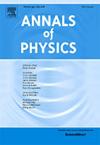f(Q)引力下暗物质星系晕内受艾因纳斯托启发的非对易黑洞
IF 3
3区 物理与天体物理
Q2 PHYSICS, MULTIDISCIPLINARY
引用次数: 0
摘要
本文旨在讨论利用f(Q)引力模型构建非交换暗物质引力受限构型的可能性。为了达到这个目的,我们考虑f(Q)的线性表示,f(Q)=σ0Q+σ1,其中σ0和σ1是自由参数,Q表示与理论相关的非度量性。为了模拟引力场的非交换涂抹源,我们纳入了Einasto密度分布,该分布推广了微型黑洞结构,并将暗物质作为该结构的可能物质组成部分。我们展示了线性f(Q)模型与Einasto模型的结合,通过de sitter启发的状态方程机制,使不同暗物质星系晕的表述成为可能。此外,我们证明了使用非定域状态方程导致恒星构型的形成,涂抹模糊液滴。然而,在这些扩散的液滴恒星分布中的径向压力仍然是负的。通过发展受普遍暗物质模型约束的扩散暗物质模糊结构,我们研究了黑洞与超大质量天体物理结构之间可能的引力联系。我们将这些恒星结构分为三种不同的类别:没有视界的模糊自引力液滴,有单一视界的模糊黑洞,以及有两个视界的黑洞物体。我们的研究重点是确定这些自引力黑洞结构是否存在于星系中心。本文章由计算机程序翻译,如有差异,请以英文原文为准。
Einasto-inspired non-commutative black holes within dark matter galactic halos in f(Q) gravity
This manuscript aims to discuss the possible construction of non-commutative dark matter gravitationally confined configurations using the model of gravity. To achieve this goal, we consider a linear representation of , given by , where and are free parameters, and denotes the non-metricity associated with the theory. To model the non-commutative smeared sources of the gravitational field, we incorporate the Einasto density distribution, which generalizes mini black hole structures and also accounts for dark matter as a possible matter component of the structure. We show that the combination of a linear model with the Einasto model, through the mechanism of a de Sitter-inspired equation of state, enables the formulation of different dark matter galactic halos. Additionally, we demonstrate that using a nonlocalized equation of state leads to the formation of stellar configurations, smeared fuzzy droplets. However, the radial pressure within these diffused droplet stellar distributions remains negative. By developing diffused dark-matter fuzzy structures subject to the prevalent dark-matter models, we investigate the possible gravitational connection between black holes and supermassive astrophysical structures. We classify these stellar configurations into three distinct categories: fuzzy self-gravitating droplets with no event horizon, fuzzy black holes with a single horizon, and black hole objects with two horizons. Our investigation focuses on determining if these self-gravitating black hole structures can exist at galactic centers.
求助全文
通过发布文献求助,成功后即可免费获取论文全文。
去求助
来源期刊

Annals of Physics
物理-物理:综合
CiteScore
5.30
自引率
3.30%
发文量
211
审稿时长
47 days
期刊介绍:
Annals of Physics presents original work in all areas of basic theoretic physics research. Ideas are developed and fully explored, and thorough treatment is given to first principles and ultimate applications. Annals of Physics emphasizes clarity and intelligibility in the articles it publishes, thus making them as accessible as possible. Readers familiar with recent developments in the field are provided with sufficient detail and background to follow the arguments and understand their significance.
The Editors of the journal cover all fields of theoretical physics. Articles published in the journal are typically longer than 20 pages.
 求助内容:
求助内容: 应助结果提醒方式:
应助结果提醒方式:


